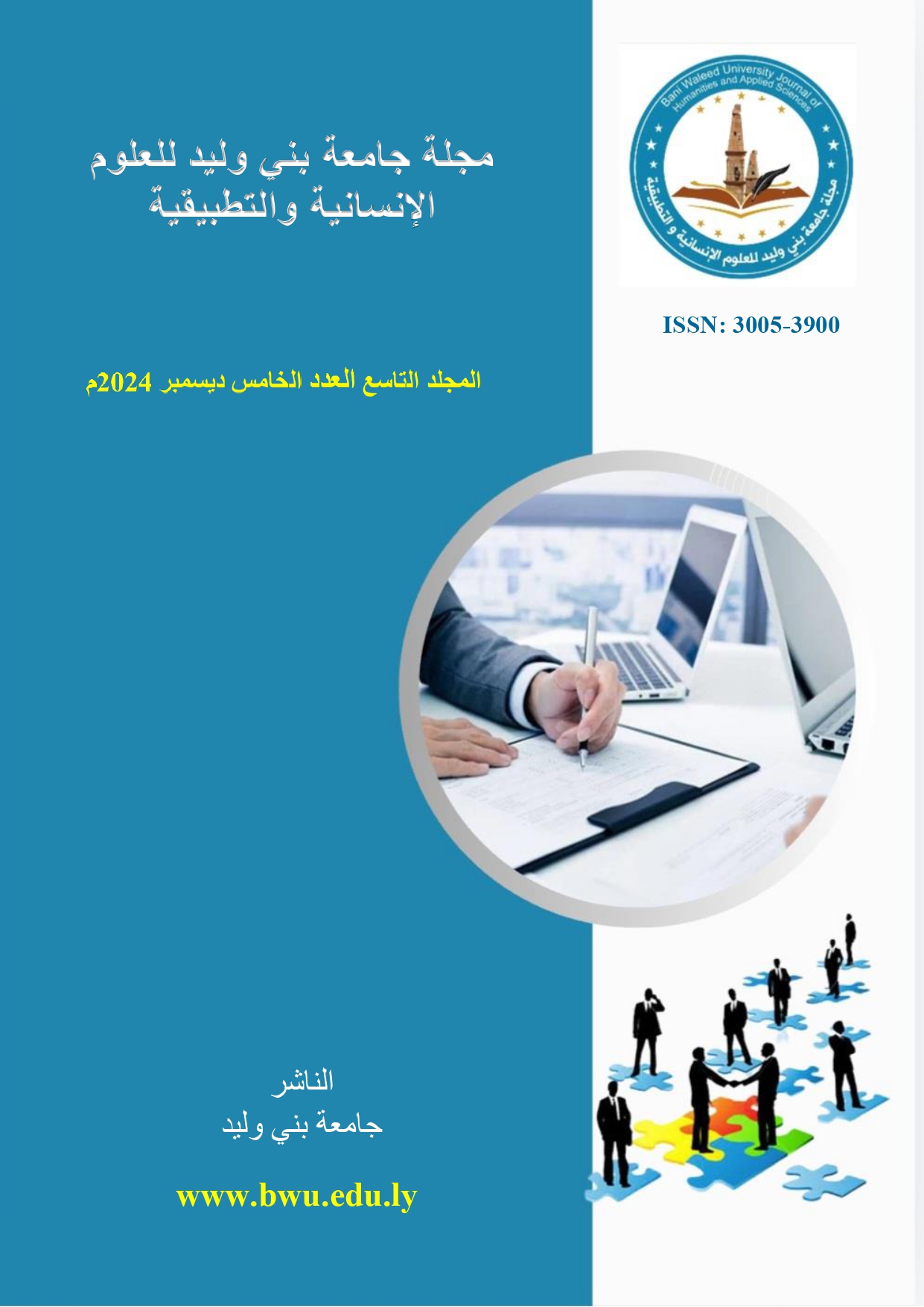Effects of Shot Peening Cyclic Load on Fatigue Crack Propagation Life of 2024T351 Aluminum Alloy
DOI:
https://doi.org/10.58916/jhas.v9i5.561Keywords:
Shot peen, Cyclic load, Fatigue life, intensity, Residual stressAbstract
Surface treatments like shot peening are frequently employed to bolster the fatigue resistance of components. This study entails simulation and experimental investigations conducted on 2024-T351 aluminum alloy specimens subjected to three distinct shot peening treatments. The experiments involved subjecting specimens to varying intensities shot peening categorized as 4-6A, 6-8A, and 8-10A, followed by cyclic loading tests. Two different stress levels, 170MPa and 280MPa, were applied during cyclic tests for varying cycle counts ranging from 1 to 10,000 cycles. The enhanced fatigue life of peened specimens exhibited a notable increase of 28%, contingent upon the shot peening parameters. Specifically, employing higher shot peening parameters such as material of shot peen, peening velocity, and size led to greater layer of residual stresses, thereby improving fatigue life. These beneficial effects serve to impede crack initiation and propagation on component surfaces, consequently retarding crack propagation rates. Fatigue life estimation for the 2024-T351 aluminum alloy can be derived from the S-N curve based on the maximum stress experienced by the specimen. Notably, simulation results closely aligned with experimental findings.
Downloads
References
Li, H. X., Bai, Q. L., Li, Y., Du, Q., Katgerman, L., Zhang, J. S., & Zhuang, L. Z. (2017). Mechanical properties and cold cracking evaluations of four 7××× series aluminum alloys using a newly developed index. Materials Science and Engineering: A, 698, 230-237.
Pongen, R., Birru, A. K., & Parthiban, P. (2019). Study of microstructure and mechanical properties of A713 aluminium alloy having an addition of grain refiners Al-3.5 Ti-1.5 C and Al-3Cobalt. Results in Physics, 13, 102-105.
Zhou, P., Song, Y., Hua, L., Lu, J., Zhang, J., & Wang, F. (2019). Mechanical behavior and deformation mechanism of 7075 aluminum alloy under solution induced dynamic strain aging. Materials Science and Engineering: A, 759, 498-505.
Chen, S. Y., Chen, K. H., Dong, P. X., Ye, S. P., & Huang, L. P. (2014). Effect of heat treatment on stress corrosion cracking, fracture toughness and strength of 7085 aluminum alloy. Transactions of Nonferrous Metals Society of China, 24(7), 2320-2325.
Chausov, M., Zasimchuk, E., Maruschak, P., Khyzhun, O., Pylypenko, A., Prentkovskis, O., & Brezinová, J. (2021). Influence of impact-oscillatory loading on fatigue life of aluminium alloy 2024-T351. Iranian Journal of Science and Technology, Transactions of Mechanical Engineering, 1-10.
Han, N., Zhang, X., Liu, S., Ke, B., & Xin, X. (2011). Effects of pre-stretching and ageing on the strength and fracture toughness of aluminum alloy 7050. Materials Science and Engineering 528(10-11), 3714-3721.
G. da Silva Savonov, M.G.G. Camarinha, L.O. Rocha, M.J.R. Barboza, G.V. Martins, D.A.P. Reis, (2023). Study of the influence of the RRA thermal treatment and plasma nitriding on corrosion behavior of 7075-T6 aluminum alloy, Surf. Coating. Technol. 374 736-744.
Ye, Z., Liu, D., Zhang, X., Wu, Z., & Long, F. (2019). Influence of combined shot peening and PEO treatment on corrosion fatigue behavior of 7A85 aluminum alloy. Applied Surface Science, 486, 72-79.
Azarniya, A., Taheri, A. K., & Taheri, K. K. (2019). Recent advances in ageing of 7xxx series aluminum alloys: A physical metallurgy perspective. Journal of Alloys and Compounds, 781, 945-983.
Chobaut, N., Carron, D., Arsène, S., Schloth, P., & Drezet, J. M. (2015). Quench induced residual stress prediction in heat treatable 7xxx aluminium alloy thick plates using Gleeble interrupted quench tests. Journal of Materials Processing Technology, 222, 373-380.
Ma, J., Wen, J., Li, Q., & Zhang, Q. (2013). Electrochemical polarization and corrosion behavior of Al–Zn–In based alloy in acidity and alkalinity solutions. International Journal of Hydrogen Energy, 38(34), 14896-14902.
Ma, J., Qin, C., Li, Y., Ren, F., Liu, Y., & Wang, G. (2019). Properties of reduced graphene oxide for Mg-air battery. Journal of Power Sources, 430, 244-251.
Davis, J. R. (1993). Aluminum and aluminum alloys. ASM international.
Mattson, R. L., & Coleman Jr, W. S. (1954). Effect of shot-peening variables and residual stresses on the fatigue life of leaf-spring specimens. SAE Transactions, 546-556.
Zaroog, O.S., A. Ali, B. Sahari and R. Zahari (2009), Relaxation of compressive residual stress. Part 1: Relaxation of stage I. Journal of Scientific & Industrial Research,. 68(12): p. 1035-1037.
Torres, M. A. S., & Voorwald, H. J. C. (2002). An evaluation of shot peening, residual stress and stress relaxation on the fatigue life of AISI 4340 steel. International Journal of Fatigue, 24(8), 877-886.
Story, J., G. Jarvis, H. Zonker and S. Murtha, (1993). Issues and trends in automotive aluminum sheet forming, SAE Technical Paper.
Yuan, T., Dou, M., Liu, L., Li, L., Sun, S., & Hu, C. (2023). Improving high temperature fretting fatigue performance of nickel-based single crystal superalloy by shot peening. International Journal of Fatigue, 171, 107-563.
Meng, X., Leng, X., Shan, C., Zhou, L., Zhou, J., Huang, S., & Lu, J. (2023). Vibration fatigue performance improvement in 2024-T351 aluminum alloy by ultrasonic-assisted laser shock peening. International Journal of Fatigue, 168, 107-471.
Hu, Y., Cheng, H., Yu, J., & Yao, Z. (2020). An experimental study on crack closure induced by laser peening in pre-cracked aluminum alloy 2024-T351 and fatigue life extension. International Journal of Fatigue, 130, 105232.
Zhang, M., Li, J., Song, H., & Zhang, S. (2024). Comparative study on the fatigue properties and dislocation evolution of three kinds of aluminum alloys. International Journal of Fatigue, 178, 108001.
Qin, Z., Li, B., Zhang, H., Wilfried, T. Y. A., Gao, T., & Xue, H. (2022). Effects of shot peening with different coverage on surface integrity and fatigue crack growth properties of 7B50-T7751 aluminum alloy. Engineering Failure Analysis, 133, 106010.
Kuyucak, S., & Sahoo, M. (1996). A review of the machinability of copper-base alloys. Canadian Metallurgical Quarterly, 35(1), 1-15.
ASTM, E. (2007). Standard practice for conducting force controlled constant amplitude axial fatigue tests of metallic materials. West Conshohocken













